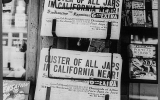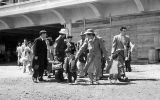
Steve Okamoto has seen the black and white photograph many times. Still, he leans in for a closer look at the faces of the men and women lined up on San Francisco’s Bush Street.
The men in suits and the women in dresses wait outside the Wartime Civil Control Administration. The time is two months after the Japanese attack on Pearl Harbor. President Franklin D. Roosevelt had issued Executive Order 9066, clearing the way for the forced relocation of Japanese Americans to internment camps.
“My parents," Okamoto said, "may have been in this line.”
His family was sent from their San Francisco home to the Tanforan Assembly Center, a government-run camp located at the Tanforan horse racing track in San Bruno. “I was only six weeks old,” he said. “They were allowed to take only what they could carry. My mother carried me and held the hand of my sister so you can imagine my father carrying everything for the four of us.”
His family, like many others, were forced to live in horse stalls with dirt floors covered by straw until more permanent internment camps were built in the deserts of California, Utah, Arizona and elsewhere.
“After the war when we returned to San Francisco most families wanted to assimilate,” he said. “My parents wouldn’t even speak Japanese to us, even though they were bilingual. They didn’t talk much about the camp but what my mother told me is that she could never forget the awful smell.”
Okamoto’s hope is that future generations never forget the impact of bigotry and scapegoating an entire race. He is working with other volunteers to create a memorial to the 8,000 Japanese Americans who were imprisoned at Tanforan. The memorial would be located on a plaza just outside the San Bruno BART station and next to the Shops at Tanforan, the mall that replaced the race track decades ago.

“It was an injustice that never should have happened but did,” said Doug Yamamoto, president of the Tanforan Assembly Center Memorial Committee, which is spearheading the project. “Never again should the government take away people’s rights. This should serve as a reminder.”
Photo from the Museum of the City of San Francisco.
To keep the memory alive, the San Mateo County Board of Supervisors in June 2016 granted the committee $250,000 toward building the memorial and a bronze statue featuring two young girls. The memorial will also include interpretive panels that tell the history of the internment with quotes from those who spent time at Tanforan.
The grant is from Measure A, the half-cent countywide sales tax approved by voters in 2012. Voters in November 2016 extended the sales tax for an additional 20 years in a proposition listed as Measure K on the ballot.
The funding, coupled with a $363,839 grant from the National Park Service Japanese American Confinement Sites program, puts the Tanforan Memorial Committee more than halfway toward its fundraising goal.
“The grant by the Board of Supervisors lets other potential donors know that this project is for real,” Yamamoto said. His parents were interred during the war, his mother in Poston, Ariz., and his father in Amache, Colo.
Dave Pine, the San Mateo County Supervisor who recommended the project for funding, sees unsettling parallels between the treatment of Japanese Americans more than seven decades ago and today’s heated political debates about immigration and the treatment of Muslims.
“Most of the Japanese Americans who were interned at Tanforan were U.S. citizens,” Pine said. “Building this memorial is a sober reminder of what can happen when emotions and fear run high. It is absolutely critical that we preserve lessons from our history so that we never again make the same mistakes.”

Horse stalls were remodeled into living quarters for thousands of Japanese Americans forced to live at the Tanforan Assembly Center. Photo courtesy Tanforan Assembly Center Memorial Committee.
The idea for the memorial grew out of a photo project to commemorate the 70th anniversary of the 1942 opening of the Tanforan Assembly Center.
Dorothea Lange, who gained fame for her Depression-era photographs of migrant workers, covered the internment for the War Relocation Authority. She took photos of families as they prepared to leave their homes and as they arrived in camps to dehumanizing conditions.
Decades later, photographer Paul Kitagaki, Jr. learned from a family member that Lange had photographed his grandparents, father and other family members as they waited for a bus in Oakland to begin their journey to detention. He eventually found original images of his family in the National Archives in Washington, D.C.
That propelled Kitagaki to search for the identities of those in other photos. He has since photographed more than two dozen of the original subjects, or their direct descendants. A gallery of Lange’s photos coupled with his recent photos is on display at the San Bruno BART station and will be incorporated into the memorial.
The memorial will also include replicas of horse stalls where families were forced to live
Karyl Matsumoto, a member of the South San Francisco City Council, serves on the Memorial Committee Board of Directors. She has collected numerous stories from those who were incarcerated and often gives talks about the incarceration at libraries and schools.
“I ask children to imagine if they had seven days to leave their homes and they could only take what they could carry,” she said. “There were being sent off into the unknown while all of their belongings they couldn’t carry were confiscated and sold.”
Doug Yamamoto, left, Karyl Matsumoto and Steve Okamoto at the current display at the San Bruno BART station.
Published Aug. 11, 2016.
Note: this article was updated on Dec. 28, 2016, to reflect that the Measure A sales tax approved by voters in 2012 is now known as Measure K. Voters in November 2016 extended the sales tax for an additional 20 years in a proposition listed as Measure K on the ballot.
Want to learn more about how Measure K funds are impacting Community Services?
Click here for updates and archived stories on our Measure K initiatives.

A newstand in Oakland in February 1942. Courtesy Library of Congress.

Families arrive at the Tanforan Assembly Center in this Dorothea Lange photograph from April 1942 taken for the War Relocation Authority. Photo from the Museum of the City of San Francisco.
An artist's rendering of the memorial features two sisters. It is inspired by a Dorothea Lange photograph. Courtesey of the Tanforan Memorial Assembly Center Memorial Committee.
This plaque, located in a small garden at the front of The Shops at Tanforan, was dedicated in September 2007 to memorialize those who lived under armed guard at the former Tanforan race track.